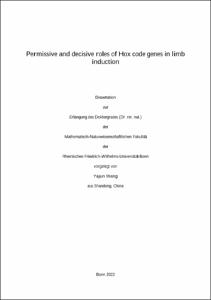Wang, Yajun: Permissive and decisive roles of Hox code genes in limb induction. - Bonn, 2022. - Dissertation, Rheinische Friedrich-Wilhelms-Universität Bonn.
Online-Ausgabe in bonndoc: https://nbn-resolving.org/urn:nbn:de:hbz:5-67172
Online-Ausgabe in bonndoc: https://nbn-resolving.org/urn:nbn:de:hbz:5-67172
@phdthesis{handle:20.500.11811/10172,
urn: https://nbn-resolving.org/urn:nbn:de:hbz:5-67172,
author = {{Yajun Wang}},
title = {Permissive and decisive roles of Hox code genes in limb induction},
school = {Rheinische Friedrich-Wilhelms-Universität Bonn},
year = 2022,
month = aug,
note = {Vertebrates display positional identities along the head-to-tail axis. The forelimb is one of the characteristics among them that shows its specific position at the interface between the cervical and thoracic region independent of the length of the neck of animals. The axial identities, including limb positioning, are determined by the temporal and spatial collinearity expression pattern of Homeobox (Hox) genes. This can be realized through their collinearity activation during gastrulation. Hox PG 4-5 genes, whose down-regulation in mice induces homeotic transformations in the cervical-thoracic interface, activate Tbx5 transcription. Tbx5 is the first factor to initiate forelimb bud formation from the dorsal layer of the lateral plate mesoderm. The expression of Hox PG 9 inhibits Tbx5 expression, thus limiting the posterior boundary of the forelimb. However, which Hox genes determine the anterior boundary of the forelimb is still not clear. Considering the expression pattern of Hox PG 6-7 genes during forelimb induction, I hypothesized that Hox PG 6-7 genes participate in regulating the anterior forelimb boundary. The hypothesis was experimentally performed in chick embryos. Before manipulating gene expression, I first identified the prospective wing region using DiI and EGFP labeling approaches and found that the wing-forming mesoderm maintains its axial level from generation to differentiation. The anterior boundary of the wing bud is located at the level of the prospective somite 15/16. Then, I electroporated constructs expressing Hox PG 6-7 into the dorsal lateral plate mesoderm anterior to the prospective wing region. This ectopic expression caused additional wing buds formation anterior to the endogenous ones. In situ hybridization and mRNA sequencing data indicated that the ectopic wing buds have partial similarities to the normal wing bud. Hence, Hox PG 6-7 are sufficient to induce forelimb buds. To demonstrate the functional correlation of Hox PG 4-5 and Hox PG 6-7 genes, the dominant-negative form of Hoxb4 was electroporated into the prospective wing mesoderm, resulting in a flattened wing bud. This observation identified the necessity of Hox PG 4-5 genes in forelimb induction. In summary, the anterior boundary of the forelimb is regulated by two functionally distinct Hox gene groups. While Hox PG 4-5 genes initiate Tbx5 expression, Hox PG 6-7 genes maintain Tbx5 expression to instruct the forelimb formation. This permissive and decisive induction would be a general mechanism for the combinatory functions of a Hox code for morphogenesis and organogenesis.},
url = {https://hdl.handle.net/20.500.11811/10172}
}
urn: https://nbn-resolving.org/urn:nbn:de:hbz:5-67172,
author = {{Yajun Wang}},
title = {Permissive and decisive roles of Hox code genes in limb induction},
school = {Rheinische Friedrich-Wilhelms-Universität Bonn},
year = 2022,
month = aug,
note = {Vertebrates display positional identities along the head-to-tail axis. The forelimb is one of the characteristics among them that shows its specific position at the interface between the cervical and thoracic region independent of the length of the neck of animals. The axial identities, including limb positioning, are determined by the temporal and spatial collinearity expression pattern of Homeobox (Hox) genes. This can be realized through their collinearity activation during gastrulation. Hox PG 4-5 genes, whose down-regulation in mice induces homeotic transformations in the cervical-thoracic interface, activate Tbx5 transcription. Tbx5 is the first factor to initiate forelimb bud formation from the dorsal layer of the lateral plate mesoderm. The expression of Hox PG 9 inhibits Tbx5 expression, thus limiting the posterior boundary of the forelimb. However, which Hox genes determine the anterior boundary of the forelimb is still not clear. Considering the expression pattern of Hox PG 6-7 genes during forelimb induction, I hypothesized that Hox PG 6-7 genes participate in regulating the anterior forelimb boundary. The hypothesis was experimentally performed in chick embryos. Before manipulating gene expression, I first identified the prospective wing region using DiI and EGFP labeling approaches and found that the wing-forming mesoderm maintains its axial level from generation to differentiation. The anterior boundary of the wing bud is located at the level of the prospective somite 15/16. Then, I electroporated constructs expressing Hox PG 6-7 into the dorsal lateral plate mesoderm anterior to the prospective wing region. This ectopic expression caused additional wing buds formation anterior to the endogenous ones. In situ hybridization and mRNA sequencing data indicated that the ectopic wing buds have partial similarities to the normal wing bud. Hence, Hox PG 6-7 are sufficient to induce forelimb buds. To demonstrate the functional correlation of Hox PG 4-5 and Hox PG 6-7 genes, the dominant-negative form of Hoxb4 was electroporated into the prospective wing mesoderm, resulting in a flattened wing bud. This observation identified the necessity of Hox PG 4-5 genes in forelimb induction. In summary, the anterior boundary of the forelimb is regulated by two functionally distinct Hox gene groups. While Hox PG 4-5 genes initiate Tbx5 expression, Hox PG 6-7 genes maintain Tbx5 expression to instruct the forelimb formation. This permissive and decisive induction would be a general mechanism for the combinatory functions of a Hox code for morphogenesis and organogenesis.},
url = {https://hdl.handle.net/20.500.11811/10172}
}






